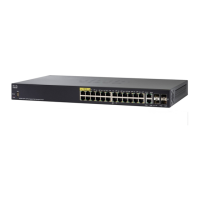Macro Commands
Cisco Sx350 Ph. 2.2.5 Devices - Command Line Interface Reference Guide 804
38
Keywords
Macros may contain keywords (parameters). The following describes these
keywords:
• A macro can contain up to three keywords.
• All matching occurrences of the keyword are replaced by the
corresponding value specified in the macro command.
• Keyword matching is case-sensitive
• Applying a macro with keywords does not change the state of the original
macro definition.
User Feedback
The behavior of a macro command requiring user feedback is the same as if the
command is entered from terminal: it sends its prompt to the terminal and accepts
the user reply.
Creating a Macro
Use the following guidelines to create a macro:
• Use macro name to create the macro with the specified name.
• Enter one macro command per line.
• Use the @ character to end the macro.
• Use the # character at the beginning of a line to enter a comment in the
macro.
In addition, # is used to identify certain preprocessor commands that can
only be used within a macro. There are two possible preprocessor
commands:
- #macro key description - Each macro can be configured with up to 3
keyword/description pairs. The keywords and descriptions are
displayed in the GUI pages when the macro is displayed.
The syntax for this preprocessor command is as follows:
#macro key description $
keyword1
description1 $keyword2 description2
$keyword3 description3
A keyword must be prefixed with '$'.
- #macro keywords - This instruction enables the device to display the
keywords as part of the CLI help. It accepts up to 3 keywords. The

